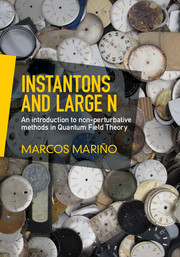Book contents
- Frontmatter
- Contents
- Preface
- Part I Instantons
- Part II Large N
- 6 Sigma models at large N
- 7 The 1/N expansion in Quantum Chromodynamics
- 8 Matrix models and matrix Quantum Mechanics at large N
- 9 Large N Quantum Chromodynamics in two dimensions
- 10 Instantons at large N
- Appendix A Harmonic analysis on S3
- Appendix B Heat kernel and zeta functions
- Appendix C Effective action for large N sigma models
- References
- Author Index
- Subject Index
6 - Sigma models at large N
from Part II - Large N
Published online by Cambridge University Press: 05 September 2015
- Frontmatter
- Contents
- Preface
- Part I Instantons
- Part II Large N
- 6 Sigma models at large N
- 7 The 1/N expansion in Quantum Chromodynamics
- 8 Matrix models and matrix Quantum Mechanics at large N
- 9 Large N Quantum Chromodynamics in two dimensions
- 10 Instantons at large N
- Appendix A Harmonic analysis on S3
- Appendix B Heat kernel and zeta functions
- Appendix C Effective action for large N sigma models
- References
- Author Index
- Subject Index
Summary
Introduction
As we have already seen in the previous chapters, developing a quantitative understanding of interacting models is a very difficult task, specially in the strong coupling regime. Usually, the only kind of approximation we have in an interacting system is perturbation theory, but often this does not capture the essential physics of the problem. In asymptotically free theories we are not always able to do perturbation theory, since the coupling depends on the energy scale, and at low energies we are always at strong coupling. Is there another type of approximation which sheds light on the strong coupling regime?
Such an approximation was first found in the context of Statistical Mechanics, and in particular in the study of models describing phase transitions, for example the ferromagnetic transition. These interacting models are also difficult to solve. A first approach to analyzing them quantitatively is to use mean-field theory, but it is known that its predictions for the critical exponents are incorrect at low dimension (for the standard Ising model with nearest-neighbor interactions, mean-field theory fails below dimension 4). This is simply because mean-field theory does not give an accurate treatment of the interactions. However, in models based on N-vector variables and with an O(N)symmetry, one can regard Nas a parameter and consider an approximation in which the number of components, N, becomes very large. In this regime, as first shown by Berlin, Kac and Stanley, one can obtain results for the critical exponents which go beyond the mean-field approximation and capture features of the strong coupling regime of the theory. Of course, this socalled large Nlimit is yet another approximation to the theory, but it is one which displays aspects of the interacting physics which are not visible in conventional treatments.
This strategy can be applied to various QFTs in various dimensions. The idea is to promote the original, finite number of fields to a large number thereof. Surprisingly, although the resulting theory has more degrees of freedom, it often simplifies as the number of fields becomes large. This is similar to the thermodynamic limit of Statistical Mechanics, in which having a very large number of degrees of freedom leads to a simplified description.
- Type
- Chapter
- Information
- Instantons and Large NAn Introduction to Non-Perturbative Methods in Quantum Field Theory, pp. 193 - 215Publisher: Cambridge University PressPrint publication year: 2015



